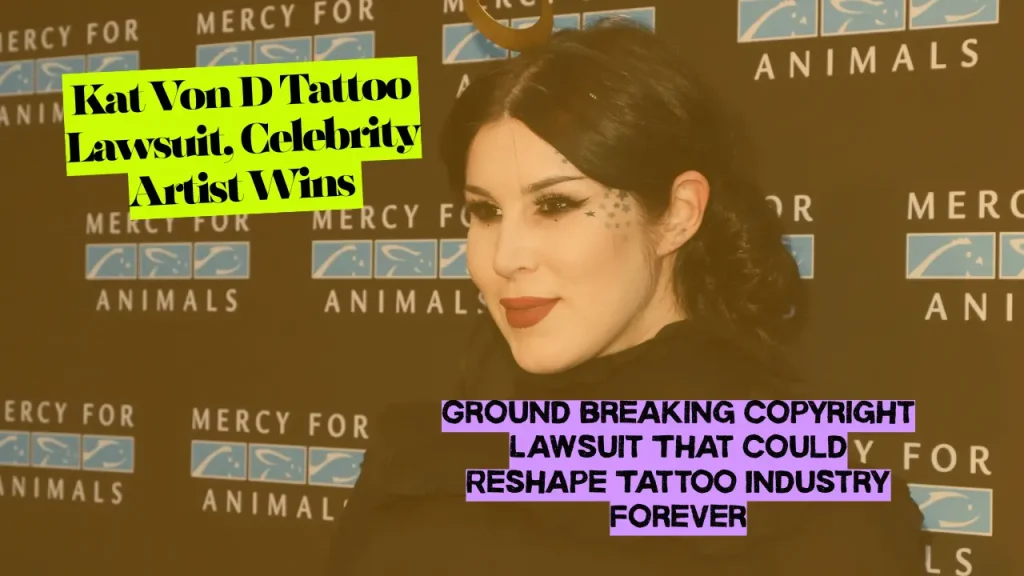Kat Von D Tattoo Lawsuit, Celebrity Artist Wins Groundbreaking Copyright Lawsuit That Could Reshape Tattoo Industry Forever
The celebrity tattoo world was forever changed when a federal jury in California found on January 26, 2024, that TV-famous tattoo artist Katherine Von Drachenberg (Kat Von D) did not infringe plaintiff Jeffrey Sedlik’s copyrighted photo of jazz artist Miles Davis. This groundbreaking legal battle represents the first major court ruling on tattoo copyright infringement and has sent shockwaves through both the art and legal communities.
The case, formally known as Sedlik v. Von Drachenberg, centered on a Miles Davis portrait tattoo that Von D created for a friend, using photographer Jeffrey Sedlik’s copyrighted image as reference material. What seemed like a routine tattoo session ultimately became a three-year legal odyssey that would establish crucial precedents for tattoo artists nationwide.
What Was the Kat Von D Tattoo Lawsuit About?
The lawsuit began in February 2021 when Jeffrey Sedlik sued Kat Von D for allegedly tattooing a version of his portrait of Miles Davis onto her friend. Sedlik, a professional photographer and professor, claimed that Von D’s tattoo violated his copyright by creating an unauthorized reproduction of his artistic work.
Kat Von D did not dispute that she used Sedlik’s photo as a reference for a tattoo she performed on a friend. However, her legal team argued that the tattoo constituted fair use and was not substantially similar enough to the original photograph to constitute copyright infringement.
The case was particularly significant because it was believed to be the ‘first-of-its-kind’ lawsuit of its nature, with potential implications for thousands of tattoo artists who regularly create artwork inspired by existing photographs, artwork, and cultural imagery.
The Legal Arguments: Copyright vs. Fair Use in Tattoo Art
Photographer’s Position
Sedlik’s legal team, led by attorney Robert Edward Allen, argued that the tattoo was a clear case of copyright infringement. “If those two things are not substantially similar, then no one’s art is safe,” Allen said. “It’s about copying others’ protected works.”
The photographer’s case rested on several key legal points:
- Direct Copying: Sedlik claimed Von D directly copied his copyrighted photograph
- Commercial Use: Although Von D didn’t charge for the specific tattoo, Sedlik argued her celebrity status and TV show created commercial benefit
- Substantial Similarity: The legal team contended the tattoo was substantially similar to the original photograph
- Copyright Management: Sedlik also alleged removal of copyright management information
Kat Von D’s Defense
Von D’s defense strategy focused on fair use protections and artistic transformation. During the three-day trial, Von D insisted that she ‘made zero money’ off the tattoo and that she’s ‘not mass-producing anything’.
Her legal arguments included:
- Transformative Use: The tattoo represented a different artistic medium with creative interpretation
- Non-Commercial Nature: The tattoo was created for a friend without payment
- Artistic Expression: Tattooing involves skill, creativity, and personal artistic vision
- Fair Use Doctrine: The use fell within acceptable fair use parameters
The Jury’s Historic Decision
The jury in downtown LA took only a few hours to decide the purportedly infringing tattoo wasn’t substantially similar to the photo. This swift decision came after a three-day trial that captivated both legal experts and the tattoo community.
The district court upheld the jury verdict finding that the tattoo created by celebrity tattoo artist Kat Von D of jazz icon Miles Davis was not substantially similar to photographer’s work, denying plaintiff’s renewed motion for judgment as matter of law and request for new trial.
The verdict included some unusual elements that legal experts found intriguing. The celebrity tattoo artist’s triumph over allegations she infringed the copyright of a photo of Miles Davis carried an unusual hitch: jury findings on fair use that appear to defy the verdict form’s instructions.
Impact on the Tattoo Industry
The Kat Von D victory has profound implications for tattoo artists across the United States. The case establishes important precedents regarding:
Artistic Freedom
The ruling suggests that tattoo artists have greater creative freedom to draw inspiration from existing works, provided their creations involve sufficient artistic transformation.
Fair Use Protection
The decision strengthens fair use protections for tattoo artists, particularly when work is done on a non-commercial basis or involves significant creative interpretation.
Industry Standards
The case provides clearer guidelines for what constitutes acceptable use versus copyright infringement in the tattoo industry.
Legal Expert Analysis
Legal professionals have offered varying perspectives on the case’s significance. The ruling has been analyzed in the context of recent Supreme Court decisions, particularly the Andy Warhol Foundation case, which addressed similar questions about artistic transformation and fair use.
Copyright attorneys note that the case highlights the evolving relationship between traditional copyright law and modern artistic practices, especially in industries like tattooing where cultural imagery and artistic interpretation intersect.
Related Lawsuit: Temu Lawsuits Over “Data-Theft Business” Allegations

What This Means for Future Tattoo Copyright Cases
The Sedlik v. Von Drachenberg decision creates important legal precedent, but questions remain about its broader application:
Ongoing Appeals
A photographer will ask the Ninth Circuit next week to erase a jury verdict that an artist’s tattoo partly made by tracing his photo of Miles Davis wasn’t similar enough to constitute copyright infringement. This appeal could further clarify the legal boundaries.
Industry Guidelines
Tattoo artists and shop owners are now seeking clearer guidelines about when reference materials cross the line into copyright infringement versus acceptable artistic inspiration.
Commercial vs. Non-Commercial Use
Future cases will likely examine the distinction between commercial and non-commercial tattoo work more closely.
Kat Von D’s Response and Career Impact
The lawsuit had a significant personal impact on Von D. The case affected Von D deeply, with reports that she wanted to ‘black-out’ all of her tattoos and expressed feeling traumatized by the legal experience.
Following the trial’s conclusion, Von D has been notably less active in tattooing, focusing instead on other business ventures including her makeup line and music career.
Related lawsuit: Capital One 360 Savings Account Lawsuit: $425 Million Settlement Approved
Frequently Asked Questions About the Kat Von D Tattoo Lawsuit
Q: What exactly was Kat Von D sued for?
A: Kat Von D was sued by photographer Jeffrey Sedlik for allegedly creating a tattoo that infringed on his copyrighted photograph of Miles Davis. Sedlik claimed the tattoo was an unauthorized reproduction of his artistic work.
Q: Did Kat Von D win or lose the lawsuit?
A: Kat Von D won the lawsuit. On January 26, 2024, a federal jury found that she did not infringe on Sedlik’s copyright, ruling that the tattoo was not substantially similar to the original photograph.
Q: Why was this lawsuit considered groundbreaking?
A: This was believed to be the first major court case dealing with tattoo copyright infringement, making it a precedent-setting decision that could impact how similar cases are handled in the future.
Q: Can tattoo artists now freely copy any photograph?
A: No. The ruling was specific to this case and its particular circumstances. Tattoo artists should still be cautious about directly copying copyrighted works and should consider fair use factors and substantial similarity tests.
Q: Is the case completely over?
A: Not necessarily. The photographer has appealed the decision to the Ninth Circuit Court of Appeals, so the final legal resolution may still be pending.
Q: How much money was involved in the lawsuit?
A: While specific monetary damages weren’t disclosed in detail, the case involved claims for actual damages, profits, and statutory damages. Von D maintained she made no money from the specific tattoo in question.
Q: What should tattoo artists learn from this case?
A: Tattoo artists should understand that using copyrighted material as reference can lead to legal challenges. The case highlights the importance of artistic transformation, non-commercial use, and understanding fair use principles.

Conclusion: A New Chapter for Tattoo Copyright Law
The Kat Von D tattoo lawsuit represents a watershed moment in the intersection of copyright law and tattoo artistry. In 2024, a verdict was reached after the jury found her not guilty of copyright, establishing important protections for tattoo artists while maintaining respect for photographers’ rights.
This case will likely be studied in law schools and referenced in future intellectual property disputes involving artistic expression and fair use. As the legal landscape continues to evolve, both tattoo artists and copyright holders will need to navigate these complex issues with greater awareness of the precedents established in Sedlik v. Von Drachenberg.
The ultimate impact of this decision may extend far beyond the tattoo industry, influencing how courts approach questions of artistic transformation, fair use, and the balance between creative freedom and intellectual property protection in our increasingly visual and artistic culture.
For tattoo artists, the case provides both encouragement and a cautionary tale about the importance of understanding copyright law while pursuing their artistic vision. For photographers and other visual artists, it underscores the need for clear licensing agreements and understanding of how their work might be interpreted and transformed by other artists.
As appeals continue and new cases emerge, the legal framework surrounding tattoo copyright will continue to develop, but the Kat Von D case will remain a foundational reference point for years to come.
This article is for informational purposes only and does not constitute legal advice. Tattoo artists and photographers should consult with qualified intellectual property attorneys for specific legal guidance.
About the Author

Sarah Klein, JD, is a licensed attorney and legal content strategist with over 12 years of experience across civil, criminal, family, and regulatory law. At All About Lawyer, she covers a wide range of legal topics — from high-profile lawsuits and courtroom stories to state traffic laws and everyday legal questions — all with a focus on accuracy, clarity, and public understanding.
Her writing blends real legal insight with plain-English explanations, helping readers stay informed and legally aware.
Read more about Sarah
